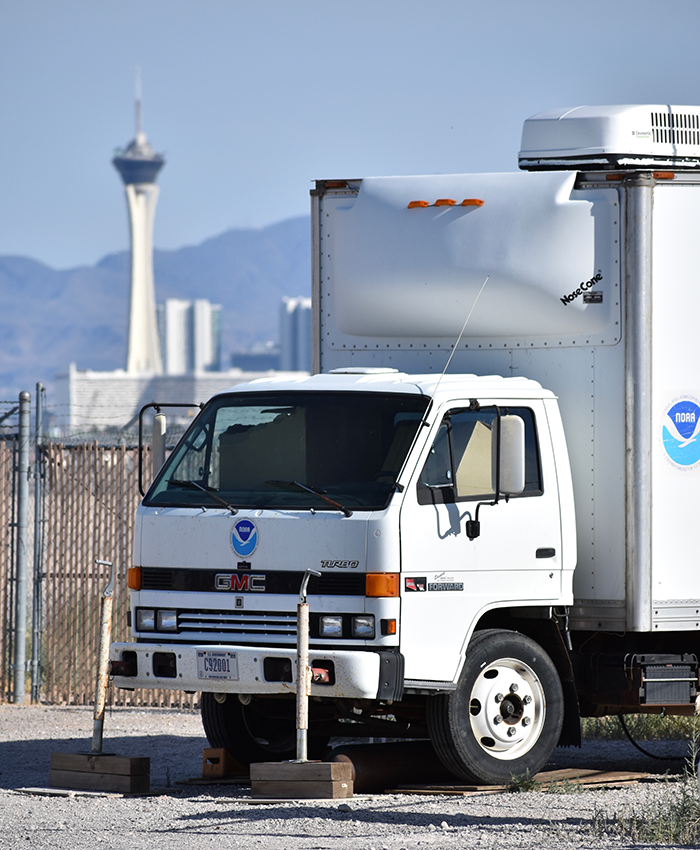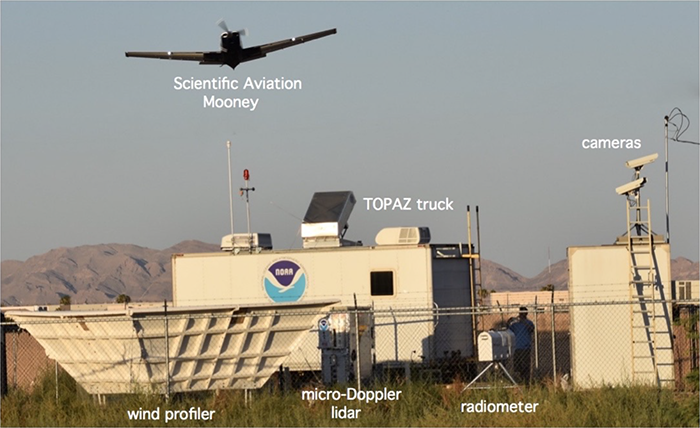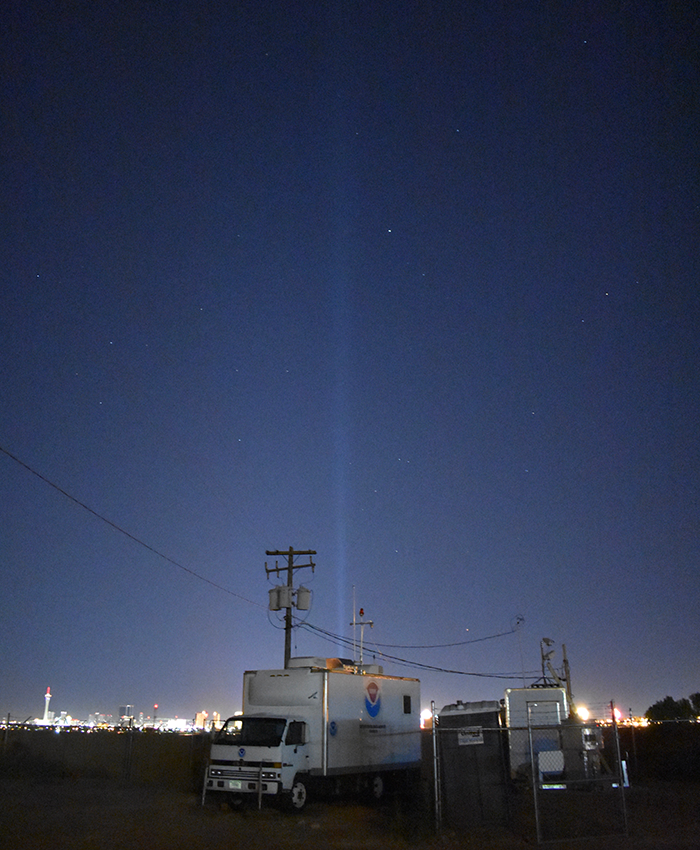A .gov website belongs to an official government organization in the United States.
A lock () or https:// means you've safely connected to the .gov website. Share sensitive information only on official, secure websites.
11 February 2022


The last two decades have witnessed significant air quality improvements in the United States with broad reductions in nitrogen dioxide (NO2), one of the photochemical precursors of ground-level ozone (O3), a serious lung irritant that is regulated by the EPA. While NO2 (which is also regulated) has declined by approximately 38% across the country, the corresponding improvements in ozone have not been uniform, with decreases of 25% in the southeastern U.S. but only 11% in the southwest.
The weaker ozone reductions in the western states are partially attributable to population growth and increased emissions from oil and gas operations, but Western cities such as Las Vegas are also plagued by high background ozone levels in the late spring and early summer months. This background comes from non-local, and more importantly non-controllable, sources that create a challenge for air quality managers. These sources include stratospheric intrusions, which transport ozone-rich air downward from the stratosphere, Asian pollution transported across the Pacific and often mixed with the stratospheric intrusions, and wildfires. These background resources are what causes surface ozone concentrations to peak in May and June at remote locations like the Grand Canyon and Great Basin National Parks instead of July and August as is typical at most other U.S. locations.
Now, new results from an in-depth study of ozone production and transport in the greater Las Vegas area, published in Atmospheric Chemistry & Physics, reveal just how much of the city's ground-level ozone may be coming from these non-local and non-controllable sources. The study, which was authored by scientists in NOAA’s Chemical Sciences Laboratory, Global Monitoring Laboratory, and Global Systems Laboratory and the Cooperative Institute for Research in Environmental Sciences at the University of Colorado Boulder (CIRES), found that non-local ozone mixed down to the surface from above contributed a striking 50-55 parts-per-billion (ppb) to ozone levels in the city during the spring and early summer. This average amount represents 70-80% of the 70 ppb regulatory threshold currently set by the US National Ambient Air Quality Standards (NAAQS).
"The high background ozone levels in the western U.S. can certainly cause some real difficulties for regulators trying to keep ozone levels below the 70 ppb threshold," explained Andy Langford, a scientist with NOAA's Chemical Sciences Laboratory and lead author of the publication. "The NAAQS is set at the same limit across the entire U.S. and doesn't account for regional differences in background sources. In the eastern states, the background is much lower and not really an issue."
These new findings come from an intensive field campaign conducted in Las Vegas in May and June of 2017 known as FAST-LVOS (Fires, Asian, and Stratospheric Transport–Las Vegas Ozone Study), which was a follow-up to the first Las Vegas Ozone Study (LVOS) conducted over the same period in 2013. This 6-week campaign used lidar, ozonesonde balloons, aircraft, and in situ measurements to investigate both ozone transported from California near the surface, and that originating from the stratosphere, Asia, or wildfires, and transported aloft. The study also investigated the local ozone production from Las Vegas urban emissions. The Las Vegas area is currently designated by the EPA as a marginal nonattainment area for ozone.

The FAST-LVOS measurements mapped ozone in the lowest 6 to 8 km of the atmosphere between Las Vegas and Barstow, California. The measurements revealed persistent layers of high ozone caused by stratospheric air and Asian pollution between 3 and 6 km above the surface on more than 75% of the days during the campaign period. The measurements documented examples of these ozone-rich layers, which had passed over California and the Sierra Nevada Mountains unscathed, being captured by the unusually deep boundary layers that form above the Desert Southwest and mixed down to the surface. In some cases, this process can directly cause ground-level ozone to exceed the NAAQS threshold – even when there is little locally generated ozone. Regional wildfire influences were also seen on several days, and likely contributed to the high surface ozone in Las Vegas on at least one occasion.
For air quality regulators, the ability to identify stratospheric or Asian pollution ozone events is critical since the Clean Air Act makes allowance for these "exceptional events" if they can be documented. Several such events occurred during the first LVOS campaign, but none were observed during FAST-LVOS. However, the 2017 campaign found many cases where high surface ozone was created by a combination of local pollution and air mixed down from above, making the attribution much less clear cut. Also, there is currently no regulatory mechanism to deal with the higher day-to-day background ozone levels caused by the many smaller transport events that occur in the late spring and early summer.
While the high background ozone in the western states can certainly be a challenge during the spring and early summer, the study authors emphasize that the influence of these transport events (and thus background ozone) diminishes in July and August when local ozone production from urban pollution emissions is at its highest.
"In other words," explained Langford, "high ozone days that exceed the NAAQS later in the summer can't really be blamed on stratospheric intrusions or Asian pollution."
Langford, A.O., C.J. Senff, R.J. Alvarez II, K.C. Aikin, S. Baidar, T.A. Bonin, W.A. Brewer, J. Brioude, S.S. Brown, J.D. Burley, D.J. Caputi, S.A. Conley, P.D. Cullis, Z. Decker, S. Evan, G. Kirgis, M. Lin, M. Pagowski, J. Peischl, I. Petropavlovskikh, R.B. Pierce, T.B. Ryerson, S.P. Sandberg, C.W. Sterling, A.M. Weickmann, and L. Zhang, The Fires, Asian, and Stratospheric Transport-Las Vegas Ozone Study (FAST-LVOS), Atmospheric Chemistry and Physics, doi:10.5194/acp-22-1707-2022, 2022.
The Fires, Asian, and Stratospheric Transport–Las Vegas Ozone Study (FAST-LVOS) was conducted in May and June of 2017 to study the transport of ozone (O3) to Clark County, Nevada, a marginal non-attainment area in the southwestern United States (SWUS). This 6-week (20 May–30 June 2017) field campaign used lidar, ozonesonde, aircraft, and in situ measurements in conjunction with a variety of models to characterize the distribution of O3 and related species above southern Nevada and neighboring California and to probe the influence of stratospheric intrusions and wildfires as well as local, regional, and Asian pollution on surface O3 concentrations in the Las Vegas Valley (≈900m above sea level, a.s.l.). In this paper, we describe the FAST-LVOS campaign and present case studies illustrating the influence of different transport processes on background O3 in Clark County and southern Nevada. The companion paper by Zhang et al. (2020) describes the use of the AM4 and GEOS-Chem global models to simulate the measurements and estimate the impacts of transported O3 on surface air quality across the greater southwestern US and Intermountain West. The FAST-LVOS measurements found elevated O3 layers above Las Vegas on more than 75% (35 of 45) of the sample days and show that entrainment of these layers contributed to mean 8 h average regional background O3 concentrations of 50–55 parts per billion by volume (ppbv), or about 85–95μgm−3. These high background concentrations constitute 70%–80% of the current US National Ambient Air Quality Standard (NAAQS) of 70 ppbv (≈120μgm−3 at 900 m a.s.l.) for the daily maximum 8 h average (MDA8) and will make attainment of the more stringent standards of 60 or 65 ppbv currently being considered extremely difficult in the interior SWUS.